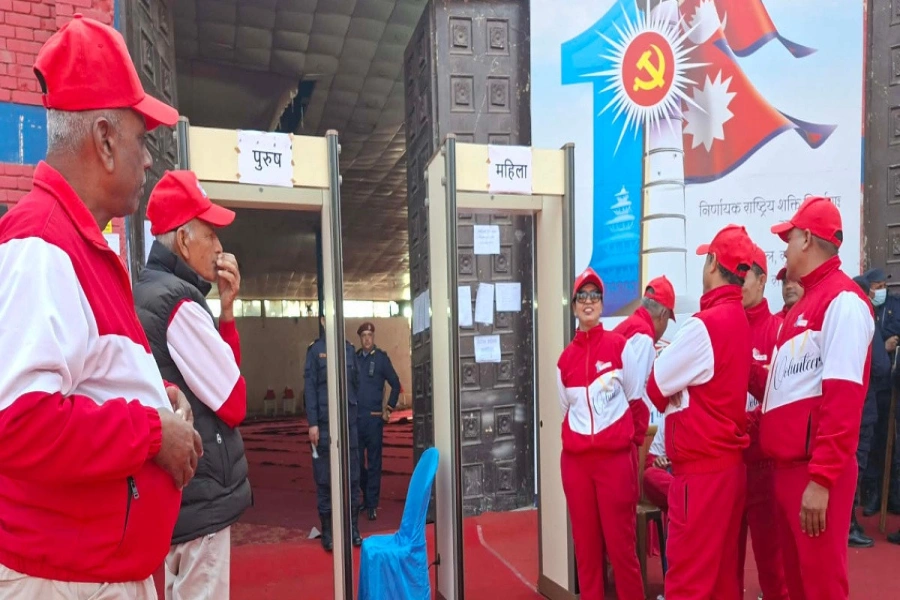Gold ornaments aren’t the only jewelry we know of these days. Everything from silver to brass and various other materials like felt and wood is used to make accessories these days. And what’s more, people seem to be favoring these jewelry items over conventional (not to mention pricey) gold rings and necklaces. The Week caught up with four different contemporary jewelry brands to bring to you their stories.
Traditional Nepali jewelry at its best
 Youngsters today aren’t very keen on wearing traditional jewelry. They don’t appreciate their aesthetics and the handcrafting that goes behind making these pieces. Sameer Shakya, one of the founders of Maya Handicrafts Jewelry, mentions that a lot of our traditional jewelry designs can’t be made anymore because the skills required to make them have been lost. “If we don’t do anything about it, a lot of other designs and pieces can also face the same fate,” he says.
Youngsters today aren’t very keen on wearing traditional jewelry. They don’t appreciate their aesthetics and the handcrafting that goes behind making these pieces. Sameer Shakya, one of the founders of Maya Handicrafts Jewelry, mentions that a lot of our traditional jewelry designs can’t be made anymore because the skills required to make them have been lost. “If we don’t do anything about it, a lot of other designs and pieces can also face the same fate,” he says.
Sameer and his wife Yasmin are currently working to make these pieces cool again. The two of them started Maya Handicrafts Jewelry about a year ago. All of their products borrow traditional Nepali designs and are made in silver. Yasmin, who lived in the Netherlands before coming to Nepal about two and a half years ago, was the one who came up with the idea of opening Maya Handicrafts Jewelry.
Because she had never seen things like Ram Leela and Tilhari before, Yasmin was fascinated by these authentic Nepali ornaments and started studying these pieces on her own accord. She discussed the idea of launching a brand that would produce only authentic Nepali designs with Sameer and the two of them launched Maya Handicrafts Jewelry after about a month of planning and prepping. Sameer mentions that, as his family is in the business of jewelry making, the whole startup process wasn’t that big of a hassle for the two of them.
The biggest challenge the two founders faced was finding artisans who could craft their products exactly the way the two of them designed them. Sameer states that an artisan who can make rings is not skilled to craft necklaces or any other products and finding crafters who have expertise in all of these specific fields is a problem they still face. Although Sameer does pitch in his designs for new products, it’s mostly Yasmin who designs Maya Handicrafts Jewelry pieces and is involved in all of the creative process. Sameer handles the technical side and the paperwork.
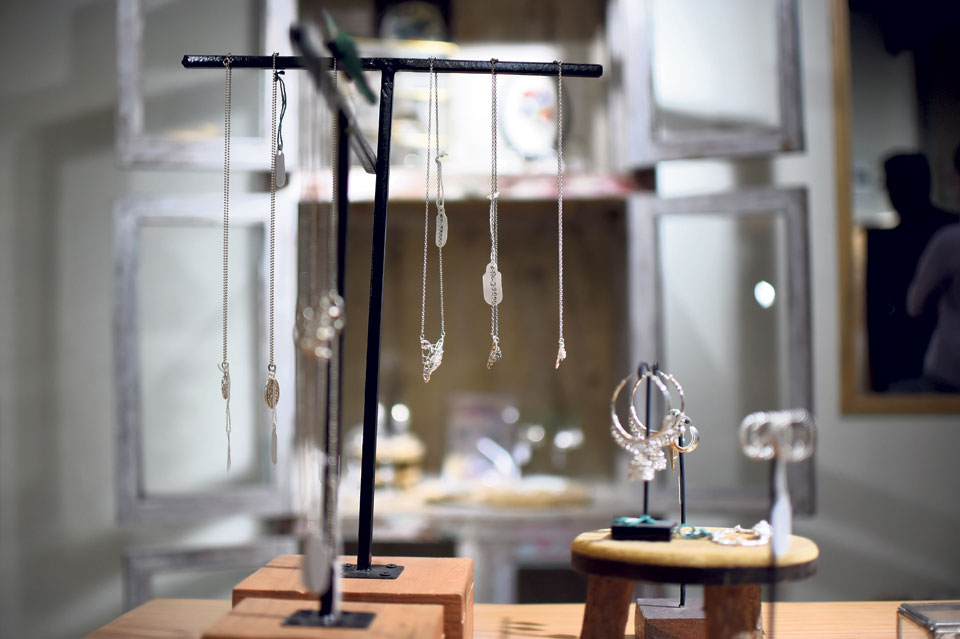 “There’s a reason why we strictly make all of our products in silver,” says Sameer adding that though Nepali jewelries are made of gold, Yasmin personally is more attached to silver. “She was also involved in jewelry business back in Netherlands and there people are more into silver jewelry than gold,” he explains.
“There’s a reason why we strictly make all of our products in silver,” says Sameer adding that though Nepali jewelries are made of gold, Yasmin personally is more attached to silver. “She was also involved in jewelry business back in Netherlands and there people are more into silver jewelry than gold,” he explains.
A big issue regarding jewelry making in Nepal, as noticed by Sameer and Yasmin, is that the crafters of these ornaments are almost always underpaid. Sameer lists this as one of the reasons why no one is interested in this profession these days. He states that because both him and Yasmin want to preserve this line of working and original Nepali jewelry designs, they think it’s their duty to pay these crafters properly and urge other jewelry brands and shops in Nepal to do the same.
Currently, Maya Handicrafts Jewelry’s products are available at various locations like Timro concept store in Pulchowk, Latitpur, One Tree Stop and their own outlet at Chhaya Mall in Durbar Marg, Kathmandu. Sameer mentions that they are also planning to open outlets in other cities of Nepal as well in the near future.
APF drafts operational policy to secure upcoming elections

Crafting for a cause
Every startup has its own story behind it. And each story is uni que, rife with its own hurdles and challenges. Himalayan Jewelry, which started in 2013, is an establishment supported and run by Sano Paila, an organization committed to redefining the development sector in different parts of Nepal.
que, rife with its own hurdles and challenges. Himalayan Jewelry, which started in 2013, is an establishment supported and run by Sano Paila, an organization committed to redefining the development sector in different parts of Nepal.
“The story of the establishment of Himalayan Jewelry is inextricably intertwined with that of Sano Paila,” says Raunak Raj Saraf, head of programs at Sano Paila. Sano Paila started in 2006 to tackle problems faced by communities in the rural areas of Nepal and currently work in 22 districts of the country to look into issues that either haven’t reached the government or are ignored by the government. In 2014, they started another program, Thulo Paila, to rescue Nepali women who were victims of human trafficking. Most of these women previously worked for Indian circuses.
Once these women were brought back to Nepal, Sano Paila helped them find and get back to their families. But a few of them couldn’t locate their family. So in order to make them able to earn a living, Sano Paila gave half of them circus trainings and the other half – who didn’t want anything to do with circuses for the rest of their lives – ornamental crafting trainings. While half of these women are currently involved in Circus Nepal, the rest are the artisans at Himalayan Jewelry.
Saraf mentions that the artisans mostly work with brass and silver for the ornaments. He also explains that although most of the designs they are currently working on are predefined designs, time and again the artisans also come up with their own creations and add that to their product list. These designs are then uploaded to Himalayan Jewelry’s Facebook page and interested customers can buy them by direct messaging them there. Saraf reveals that the past year wasn’t very good regarding the sales of their products. He mentions that although they couldn’t sell much of their jewelry, Sano Paila still distributed monthly allowances so that the artisans wouldn’t suffer.
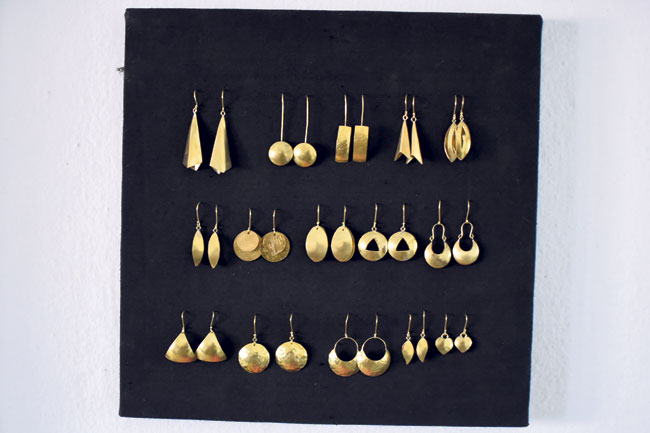 A project that Sano Paila has been working on for quite a while to help artisans involved in Himalayan Jewelry advance in their careers as jewelry crafters is Kaasya. Saraf states that Sano Paila is developing this as a brand that will be owned by the four artisans and that can help them earn their living properly and independently. He adds that the outlet for Kaasya is currently under construction at a site that is very close to Sano Paila’s regional office in Sanepa, Lalitpur and it’s scheduled to open in January this year.
A project that Sano Paila has been working on for quite a while to help artisans involved in Himalayan Jewelry advance in their careers as jewelry crafters is Kaasya. Saraf states that Sano Paila is developing this as a brand that will be owned by the four artisans and that can help them earn their living properly and independently. He adds that the outlet for Kaasya is currently under construction at a site that is very close to Sano Paila’s regional office in Sanepa, Lalitpur and it’s scheduled to open in January this year.
Of simplicity and elegance
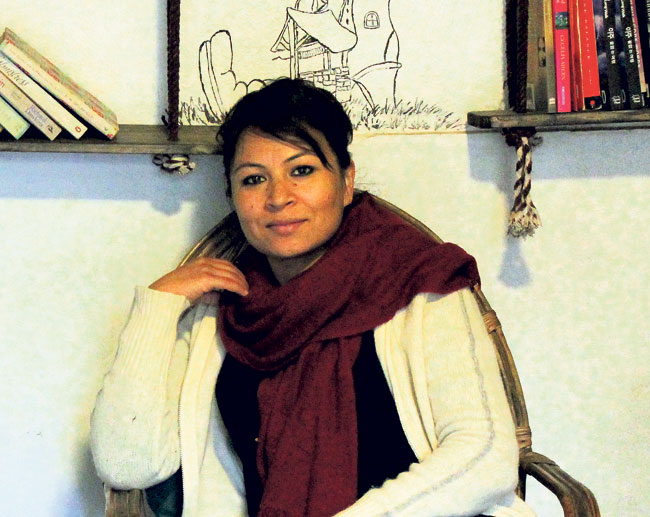 Jewelries aren’t just intricate carvings and detailed pieces, they can be in geometrics, sharp edged, or just simple lines, or so believes Sichu Khairgoli. ‘Si’ by Sichu Khairgoli has been in operations for nearly four years now and they make silver jewelries with precious/semi precious stones. Their jewelries are centerpiece oriented, meaning the designs are structured so that the gems used are the main focus and the silver simply frames the gems to complement them.
Jewelries aren’t just intricate carvings and detailed pieces, they can be in geometrics, sharp edged, or just simple lines, or so believes Sichu Khairgoli. ‘Si’ by Sichu Khairgoli has been in operations for nearly four years now and they make silver jewelries with precious/semi precious stones. Their jewelries are centerpiece oriented, meaning the designs are structured so that the gems used are the main focus and the silver simply frames the gems to complement them.
Khairgoli worked in the media for quite sometime before she started her own jewelry making business. She worked as an art director, program producer, and stylist in a number of movies and programs. Always a jewelry enthusiast, Khargoli wore various pieces on a regular basis and kept adding to her own personal collection. Through her job too she worked with several designers and artists and got acquainted with various styles and designs. Her work also required traveling so she was exposed to a whole world of crafts and designs.
She occasionally designed a few pieces for her friends upon their requests and had them custom made. Soon enough she realized that she could actually design jewelry that people would be willing to buy and wear. “Initially my designs were inspired by pieces from my own collection and from those that I was used to seeing. I definitely knew then that I preferred focused pieces to elaborate designs,” she says.
A few of her schoolmates joined her too and they collectively created a team of local artisans who had been making jewelries for generations. Although they were used to traditional designs with precise instructions, they could easily adapt to any new designs. The team works at their workshop in Thamel.
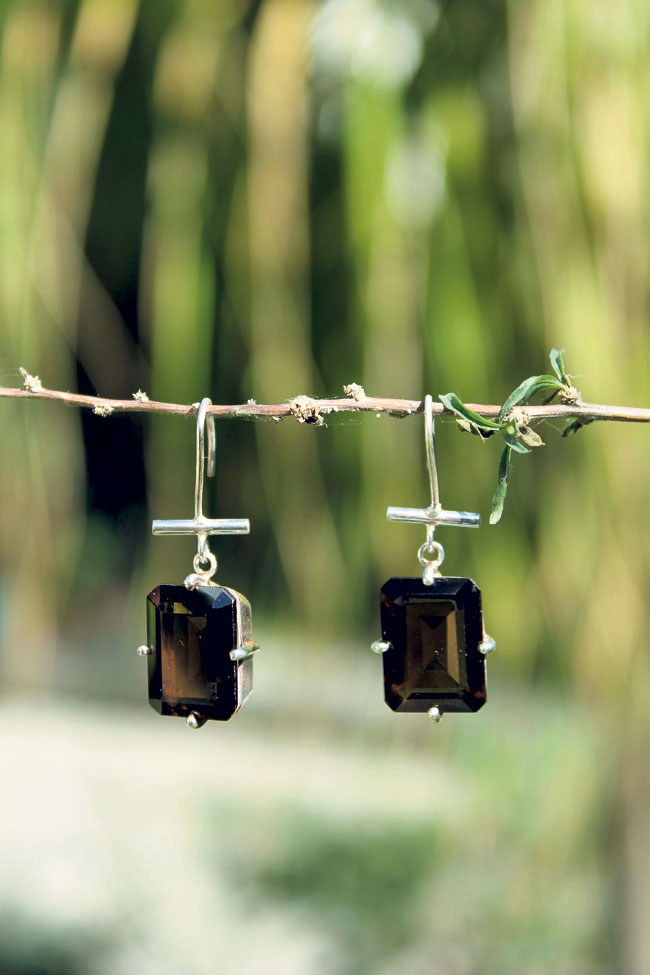 Khairgoli personally prefers jewelries that lend the wearer an elegant look. While designing she focuses on the center pieces (gems) and gives her designs geometrical shapes. “I like corners, shapes, and straight lines. And I like to incorporate these into my designs. They are simple and elegant,” she says. Although the aim is to make contemporary earrings and rings, Khairgoli makes efforts to retain traditional touches too.
Khairgoli personally prefers jewelries that lend the wearer an elegant look. While designing she focuses on the center pieces (gems) and gives her designs geometrical shapes. “I like corners, shapes, and straight lines. And I like to incorporate these into my designs. They are simple and elegant,” she says. Although the aim is to make contemporary earrings and rings, Khairgoli makes efforts to retain traditional touches too.
During a recent exhibition, Khairgoli was surprised by the interest shown by Nepali buyers. Previously her customers were from Australia and the USA and she believed that the traditional gold-wearing mass of Nepalis would be disinterested in her jewelries. But turned out, they liked her pieces and she gets commissions now on a daily basis. “Working women particularly show more interest in my designs. We’re definitely living at time when people are seeking out more options and styles and it’s very motivating for us designers,” she confirms.
A different kind of jewelry
 Lhakpa Wanglan Gurung loved drawing from a very young age. At school he remembers doodling on his notebooks more than he does studying. During weekends he spent hours drawing and later took a month long art class. It was here that he learnt about color coordination and light contours and it was also here that he began paying attention to details.
Lhakpa Wanglan Gurung loved drawing from a very young age. At school he remembers doodling on his notebooks more than he does studying. During weekends he spent hours drawing and later took a month long art class. It was here that he learnt about color coordination and light contours and it was also here that he began paying attention to details.
Later during high school an opportunity arose for him to work at a company that made handmade guitars at his hometown in Pokhara. Gurung worked there for five years and learnt the know-hows of handling wood. He had an Australian teacher who explained to him the ways to season and treat wood. “In Nepal, wood is brought in and carelessly exposed to rain water and sunlight. It is because of this that in winters people have troubles with their windows and doors. While working there for five years, I learnt all about the correct ways to use wood,” says Gurung.
When working at the guitar company, Gurung occasionally made small rings and earrings from the leftover pieces of wood. “I’m someone who always has to create, whatever it may be. I made earrings from the leftover pieces because they would have been thrown away otherwise. My brothers and friends liked them and happily bought quite a few of them. I then wondered if I could make something from my knowledge of wood and art,” he explains.
After his job he came to Kathmandu and began working on a few pieces. Initially, he would visit furniture stores and gather the leftover pieces of wood. He would then shape and carve them and finally draw on them. Each earring took two to three hours to complete. Some could also take five hours to finish. “This is a very detail oriented work so it takes time,” he clarifies.
His designs are ethnically inspired but don’t rigidly conform to them. The earrings have mandalas painted on them, have some hints of Tibetan styles and also have some natural influences. He takes customized orders sometimes. He has so far made wedding rings on three different occasions. “People these days want something new and it’s good that they do,” he adds. He sells his works through his website and at The Local Project Nepal.
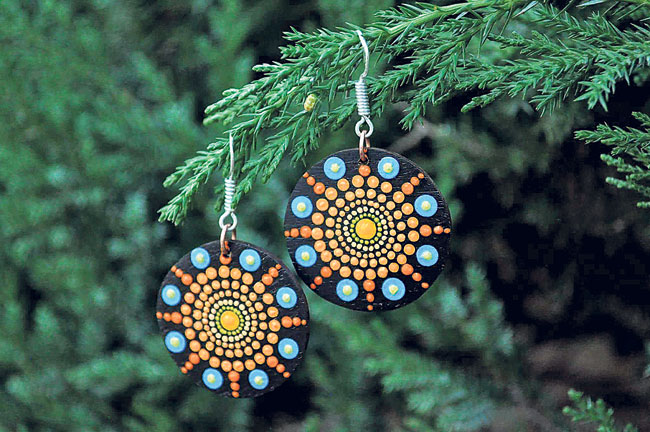 So far The Ethnic Wood has been a one man endeavor and Gurung is hesitant to hire any workers. What he likes about his work is that the only responsibility he feels is for the rings and earrings he makes. He isn’t answerable to anybody else. But if in the future, should he not be able to keep up with the demand, he is open to hiring some people. “I also want to start making guitars and I have more plans in place for my venture. So far I have taken hesitant steps but I’m becoming more confident everyday,” he concludes.
So far The Ethnic Wood has been a one man endeavor and Gurung is hesitant to hire any workers. What he likes about his work is that the only responsibility he feels is for the rings and earrings he makes. He isn’t answerable to anybody else. But if in the future, should he not be able to keep up with the demand, he is open to hiring some people. “I also want to start making guitars and I have more plans in place for my venture. So far I have taken hesitant steps but I’m becoming more confident everyday,” he concludes.






